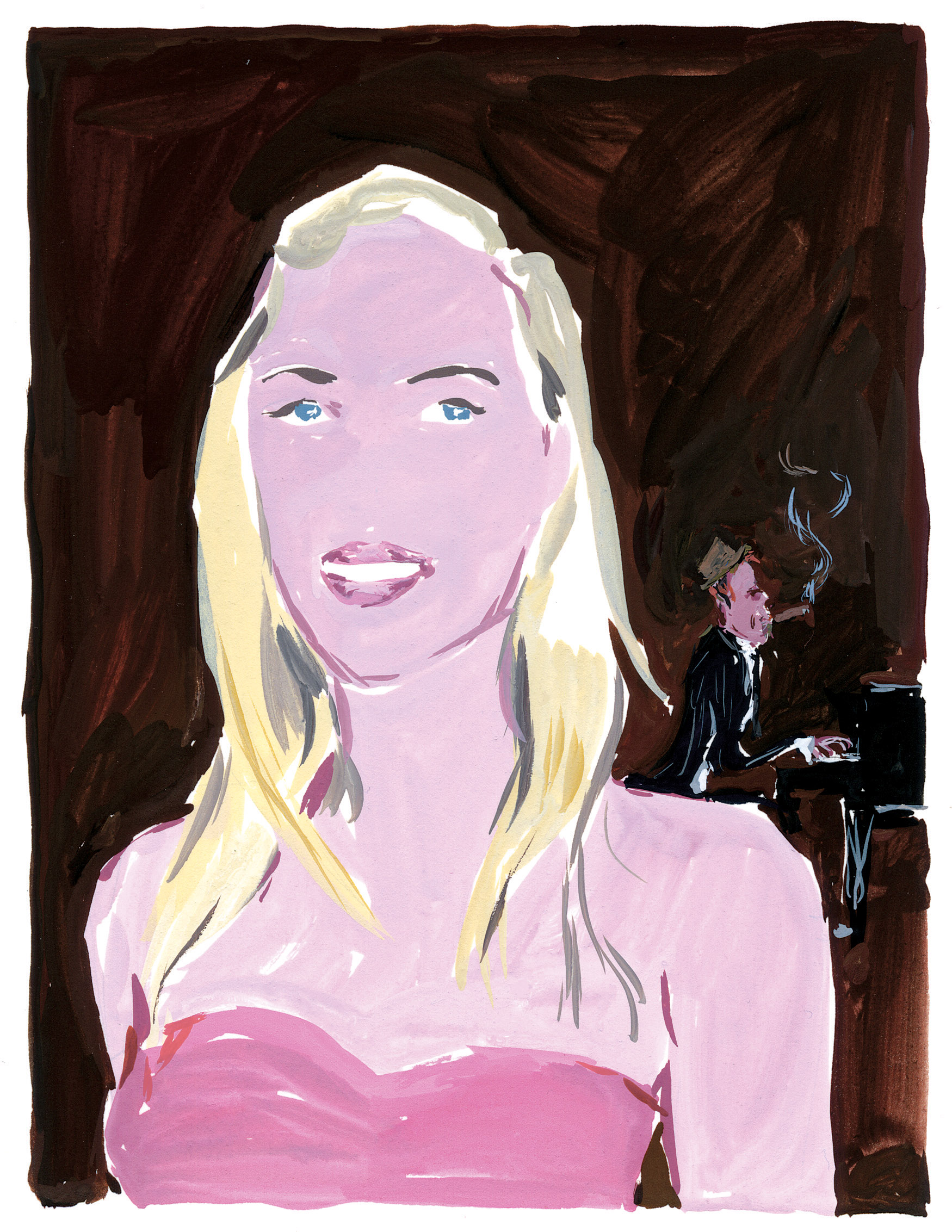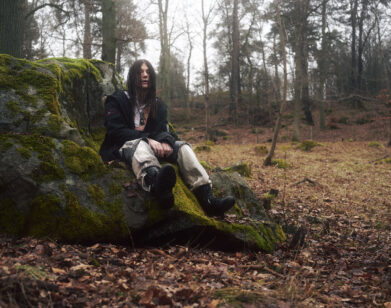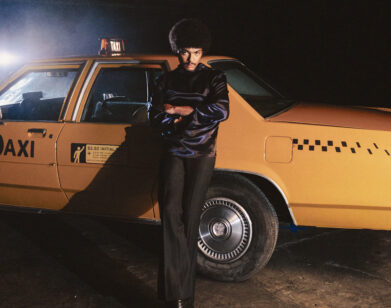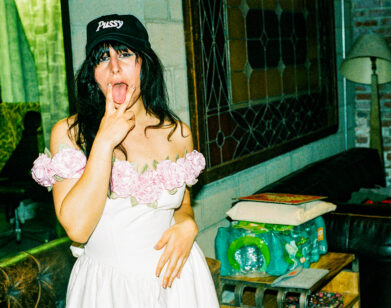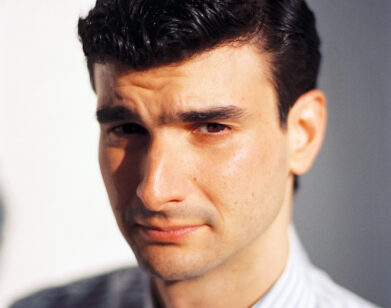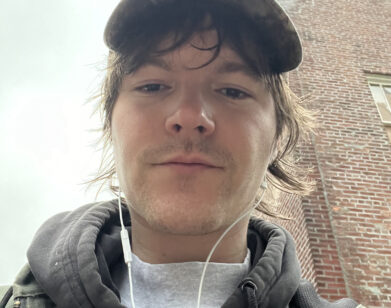Scarlett Johansson
When the news broke that Scarlett Johansson had recorded an album of Tom Waits songs, questions abounded — most commonly, “Why?” But here it is, Anywhere I Lay My Head (ATCO/Rhino), an atmospheric, almost art-rocky record of Waits tunes remade, rearranged, and reimagined with the help of Dave Sitek of the New York City indie-rock outfit TV on the Radio. Another popular query went thusly: “Scarlett Johansson’s speaking voice is deep and sort of sexy. What does her singing voice sound like?” To which we can reply: It sounds just fine, sort of appealingly androgynous in a glam-rock kind of a way. Oh, and David Bowie sings with her on two songs. Here, the actress explains it all.
STEPHEN MOOALLEM: First of all, can you walk me through how you wound up singing what is essentially a whole album of Tom Waits songs?
SCARLETT JOHANSSON: Well, I had originally recorded a song, a version of “Summertime” [by George Gershwin], for a benefit album. The album was distributed by Rhino, and the people at the label felt really pleased with the song, so they said, “Have you ever thought about recording a whole album?” I’ve just had so many friends who would kill for that opportunity that I almost couldn’t pass it up. I have always loved to sing. When I was a little girl, I wanted to be in musicals and all that kind of stuff. So it seemed like a really exciting adventure. At first, I thought I would just do an album of standards. But then I couldn’t figure out which standards to do. I did know, though, that I wanted to record this Tom Waits song called “I Never Talk to Strangers,” which is a duet that he does with Bette Midler. But I think it was kind of confusing for some people, because they couldn’t understand how a Tom Waits song could fit in with a Cole Porter song and stuff, and it turned into, Why don’t we just incorporate more Tom Waits songs into this? So I just decided to do an entire album of Tom Waits songs.
SM: And unlike a lot of other actors who’ve made albums, you didn’t just sort of enlist the pop hitmaker of the moment — there’s no Lil’ Wayne here.
SJ: [laughs] Well, I was never looking to make a pop album. It’s not to say that there’s not a place for pop-it’s just not my cup of tea. When I first started working on the album, I got some great jazz musicians together and we recorded a bunch of rough tracks, but it all sounded awful. I realized that trying to recreate Tom Waits’s sound with my voice . . . it just sounded really camp. I knew what kind of sound I wanted in my head, but I realized that I needed someone to help me get there. I was looking at certain producers who would be into the idea, and someone said, “Have you ever met Dave Sitek from TV on the Radio?” I have always been a huge fan of that band. I love that kind of massive sound that they have — so I was really curious to meet Dave. Then once we spoke, it was very obvious to both of us that we shared the same ideas.
SM: Waits’s songs are obviously very narrative-driven — they tell little stories and create little character sketches. How did you approach interpreting the songs the way you have here? Was it different for you from interpreting a character based on something you read in a script?
SJ: I think that a lot of the singers and artists that I love are very theatrical in a way, even if it’s somebody like Freddie Mercury or Marianne Faithfull, so it’s a very similar process. I mean, you spend enough time with the lyrics and they begin to take form in relation to your own life.
SM: It’s actually sort of funny to hear you sing about “the whiskers” on your “chin” on “I Wish I Was in New Orleans.”
SJ: [laughs] Obviously, with a woman singing those lines, there’s a certain irony. That song is written from such a masculine point of view that some of the lyrics took on completely different meanings. I felt very attached to that song from the beginning. It was very emotional for me to record it.
SM: Why did you feel so attached to that song in particular?
SJ: I think just because I’ve always felt such an attachment to New Orleans. I’ve worked there before and spent time there — I shot a film there called A Love Song for Bobby Long [2004] which is kind of a valentine to that city and the lifestyle that Tom Waits is sort of singing about in that song. I think that with the devastation had happened there . . . even though it’s still such a mess and such a disaster, people have stayed there and stood by it, which I think is a testament to human endurance in a way. So I felt like sort of making that song almost like a lullaby, keeping it really intimate and kind of spare.
SM: How did you first get into Tom Waits?
SJ: I first got into Tom Waits when I was, like, 11 or 12. A friend of mine, her dad listened to Tom Waits all the time, so I was introduced to his music pretty young. Then I had a boyfriend in high school who was a huge Tom Waits fan. I guess Tom Waits was always a part of my adolescence. It’s funny how the songs mean something different to me now than they did when I first heard them. I remember listening to the songs when I was a kid and laughing. Some of them are almost silly in a way, like “I Don’t Wanna Grow Up.” When you’re 12, that means something completely different to you than when you actually recognize that there’s a grown man singing that song. Just listening to certain songs, like “I’ll Shoot the Moon”-they’re very opusy and attractive for a kid in the same way that Alice in Wonderland [1951] would be or something.
SM: I have to ask you: How did David Bowie get involved in all this?
SJ: Bowie became involved in kind of an amazing way. It was incredible, actually. When I first wanted to do the Bette Midler-Tom Waits duet, I was thinking about who would I duet with, who would make it interesting. I thought, Maybe, you know, David Bowie. I’ve always loved his voice and everything about him. So I thought it would be great if he could sing the Waits part — or if he could sing the Bette Midler part and I could sing the Waits part, or something like that. I mean, a duet with David Bowie-that was, like, my 13-year-old fantasy. Then, totally fatefully, I met him at a dinner. Bowie already knew Dave Sitek because he was a big fan of TV on the Radio, so he said, “Oh, I hear you and Dave are going down to record. Good luck.” So I jokingly said, “You know, let me know if you want to come! Anytime — I’ll drive you!” And then one day when I was in Spain shooting last summer, I got this call from Dave, and he was like, “You’ll never guess who I have in the studio right now.” And, sure enough, it was Bowie. According to Dave, Bowie came in totally prepared with the sheet music and everything. He already knew what parts he was going to sing. I just, you know, basically peed myself when I found out. [both laugh] So that’s how it happened. Pretty exciting.
SM: You mentioned earlier that you were into musical theater when you were a kid. Do you remember the first musicals that you sort of cleaved to?
SJ: My mom is of the baby boomer era, and those kinds of films were, obviously, popular in the ’50s, when they made all these bright, Technicolor versions of the stage productions, like Oklahoma! [1955] and Carousel [1956] and South Pacific [1958]. I loved Flower Drum Song [1961] and all of those Rodgers and Hammerstein movies. I also always went to see a lot of musicals. So I started auditioning for that stuff. I really wanted to be in musicals when I was a kid, but my voice was kind of deep, so it was hard to find a part I could do.
SM: I wanted to ask you about that, actually, just because your voice is obviously a huge asset for you now, but I was wondering, as a kid who wanted to be in musicals, how that worked.
SJ: Or didn’t work. I struggled with it because, you know, young Cosette in Les Misérables is not singing in a baritone voice. Neither is Annie or any of the orphans. [both laugh]
Existential questioning and suffering- That’s what makes art interesting, right? Scarlett Johansson
SM: I suppose it would put an interesting spin on those productions, sort of taking them to another place.
SJ: [laughs] For sure. It would have been slightly jarring for the audience. After the 500th performance, maybe it would have been interesting to break out a little, with this pigtailed blonde-haired girl with this crazy voice.
SM: The way you looked when you were younger, if they’d put a wig on you, you would have looked like a perfect Annie. Then you’d come out with the voice. . . .
SJ: Oh, yeah. I mean, I was very innocent looking. But there were certain aspects about musical theater that I wasn’t that enthusiastic about, like dancing and choreography. It’s stuff that I love to watch, but it’s not really my forte. So it kind of became clear to me early on that it wasn’t going to happen.
SM: Do you use music at all when you’re acting?
SJ: I do sometimes. I know that a lot of actors are sort of religious about picking a soundtrack for their characters’ lives and things like that. But I think I use music more as an escape from my work. I’m not an actor that stays in character all day — I’m not a method actor or anything like that. So I think that I use music more as a way to kind of pump myself up or wind down, as opposed to associating specific songs with certain moments or trying to inspire an emotion through a song.
SM: So you’re not one of those actors who says things like, “Barbra Streisand songs make this character drink.”
SJ: No, but I can understand where that comes from. I think it’s really about whatever works for you to get that moment on celluloid.
SM: So I know that you do lighter stuff, too, but I’m looking now and you have a whole album of Tom Waits songs and I guess you just did your third Woody Allen movie, right?
SJ: Yeah.
SM: So, you know, Tom Waits and Woody Allen are very different kinds of artists, but there are some similarities there. I mean, one is all whiskey and cigarettes and beatnik melancholy, and the other is about sort of nebbish, modernist neurosis . . . but still there’s an existential-pain sort of thing happening in both of their work. Do you think you are attracted to that kind of material on some level?
SJ: Well, existential questioning and suffering — that’s what makes art interesting, right? I mean, it’s all about trying to figure out what the hell we’re doing on this crazy spinning ball of water and sand. . . . I don’t know . . . I think that anything that I do relates to that sort of cerebral questioning. Discomfort. As well as satisfaction. And, you know, I think both artists are sort of appreciative of small, satisfying things as well. . . . That sort of slice of life, in a way. You probably can’t decipher an answer out of that. [laughs]
SM: No, I can.
SJ: You know, that’s what I think attracts me to both of them — and every artist that I’ve worked with, in a way. Even if it’s someone like Frank Miller, whose mind is wandering everywhere. He knows what it’s like to have your first cigarette of the day, and that’s, like, what he can appreciate. Those little moments, he makes a big deal out of, even if it’s in a noirish, bloody massacre.

